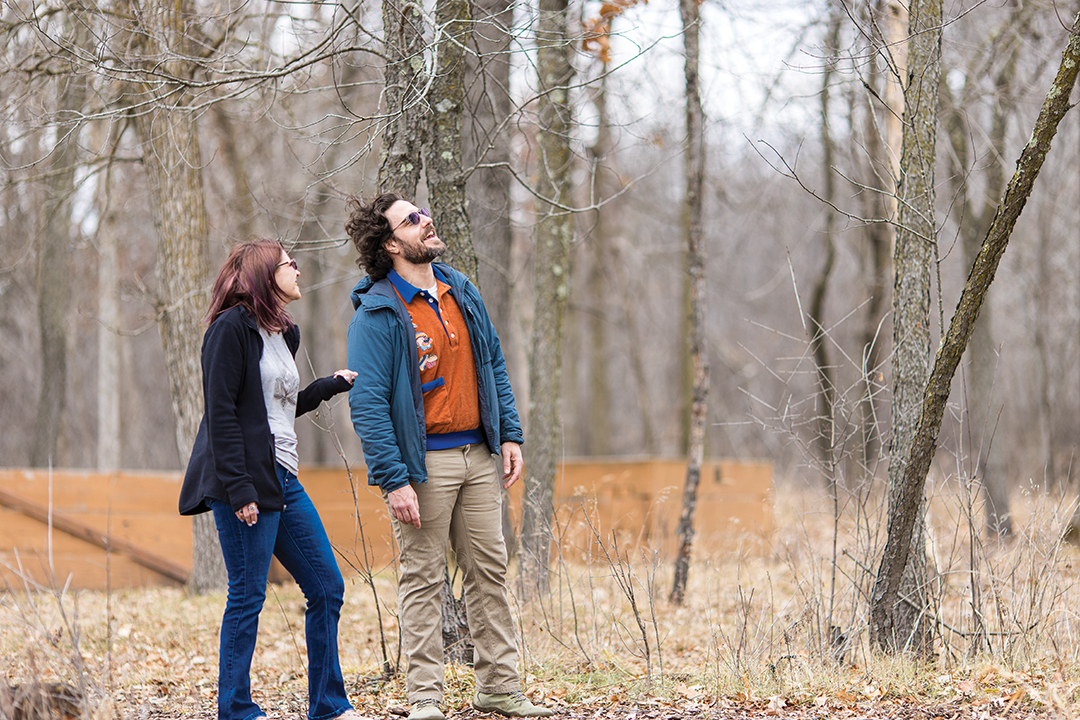
Carson Gross. Photos: Chris Emeott
Foraging experts share the natural bounty of the St. Croix Valley.
Foraging is a practice that humanity has relied on for centuries. Though it’s not as commonplace these days, the Valley provides an ideal starting place for the budding forager. Whether one hopes to find mushrooms for dinner or an herbal remedy, the wetlands, woods and prairies of this rich landscape hold much to be discovered.
The key is to know what to look for. And what better way to step into the foraging world than to connect with experts? We spoke with two local foragers to learn more about the natural bounty of the St. Croix Valley.
Heather Mashuga, an herbalist and master of holistic health studies, forages for wellness. “Some forage for food, but my main goal is to utilize plants for health and wellbeing,” Mashuga says.
What she finds—from plantain to goldenrod—will become medicinal tinctures, salves, lotions and syrups that she sells through her business, Herban Alchemy Medicaments. She prides herself on her ability to teach people “how to take health into your own hands and work with nature,” she says.

Heather Mashuga
With the St. Croix Valley also being a foraging-rich area for mushrooms, it is not uncommon to find groups of people walking at a glacial pace through the woods, looking intently at the ground and fallen trees, a field guide in hand.
Carson Gross, a local mushroom foraging instructor, says, “Edibility of mushrooms and their identification is the key to success in foraging.” He focuses expeditions on edible mushrooms, their identification and how to forage intentionally and ethically.
After an introduction to mushroom foraging, Gross says people are amazed at the diverse array of mushrooms that call the Valley home. “There are so many different colors, sizes and species in our woods to forage that the most important thing is knowing what species of mushroom you have before you eat it,” Gross says.
There are dozens of species common to the area, and they range from choice edibles like morels, chanterelles and porcini, to poisonous mushrooms, such as jack-o’-lanterns or deadly Galerina, with many more that are simply “inedible.” Gross emphasizes the importance of having a field guide, complete with pictures, during all mycology walks. The way to successfully identify your finds is to look at the caps, stems and gills.
“The St. Croix Valley has an abundance of medicinal herbs. I have worked with about 100 [varieties], 95 percent of which grow and thrive in this area. People could make their own apothecary, that will cover pretty much every ailment, just from getting to know and foraging, local medicinal plants. They are everywhere,” Mahuga says.

Mashuga and Gross are both instructers at Marine Mills Folk School.
Marine Mills Folk School
The Marine Mills Folk School opened its doors in 2018 as a response to a community need. “We support the community we are in with classes and activities,” says Kate Seitz, the school’s executive director and communications manager. Hands-on learning of traditional arts and crafts skills is the mission of the folk school. A typical week may include courses on building a wooden paddle, painting, photography, foraging and other crafts.
The folk school also hosts community events, such as weekly knit nights, monthly fix-it clinics, bluegrass jams, wood carving sessions and a beginner’s bridge group.
Both Mashuga and Gross are instructors at Marine Mills Folk School in Marine on St. Croix. To view and register for upcoming classes, visit marinemillsfolkschool.org.
Numbers to have handy while mushroom foraging: Poison help line: 800.222.1222
Animal Poison help line: 888.426.4435
Marine Mills Folk School
550 Pine St., Marine on St. Croix; 612.440.6295
Facebook: Marine Mills Folk School
Instagram: @marinemillsfolkschool






















